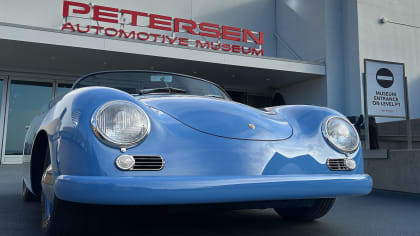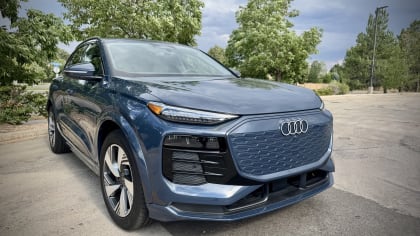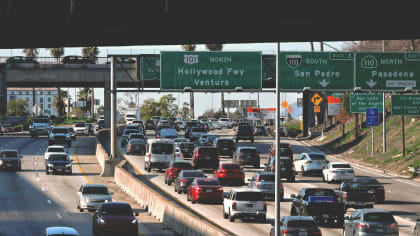Book Review - Formula 1: Car by Car 1950-59
Published on Sun, Aug 9, 2020
By: Doug Stokes
Formula 1: Car by Car 1950-59 is a vibrant look into the Golden Age that bred some of the most famous names to grace the sport, and features 600 photographs.
FORMULA 1: CAR BY CAR 1950-59
By Peter Higham
EVRO Publishing Group, UK
www.ervopublishing.com
IBSN: 978-1-910505-44-1
304 pages / 600 photos
Hardbound 11.25” x 9.50”
$79.95 USD
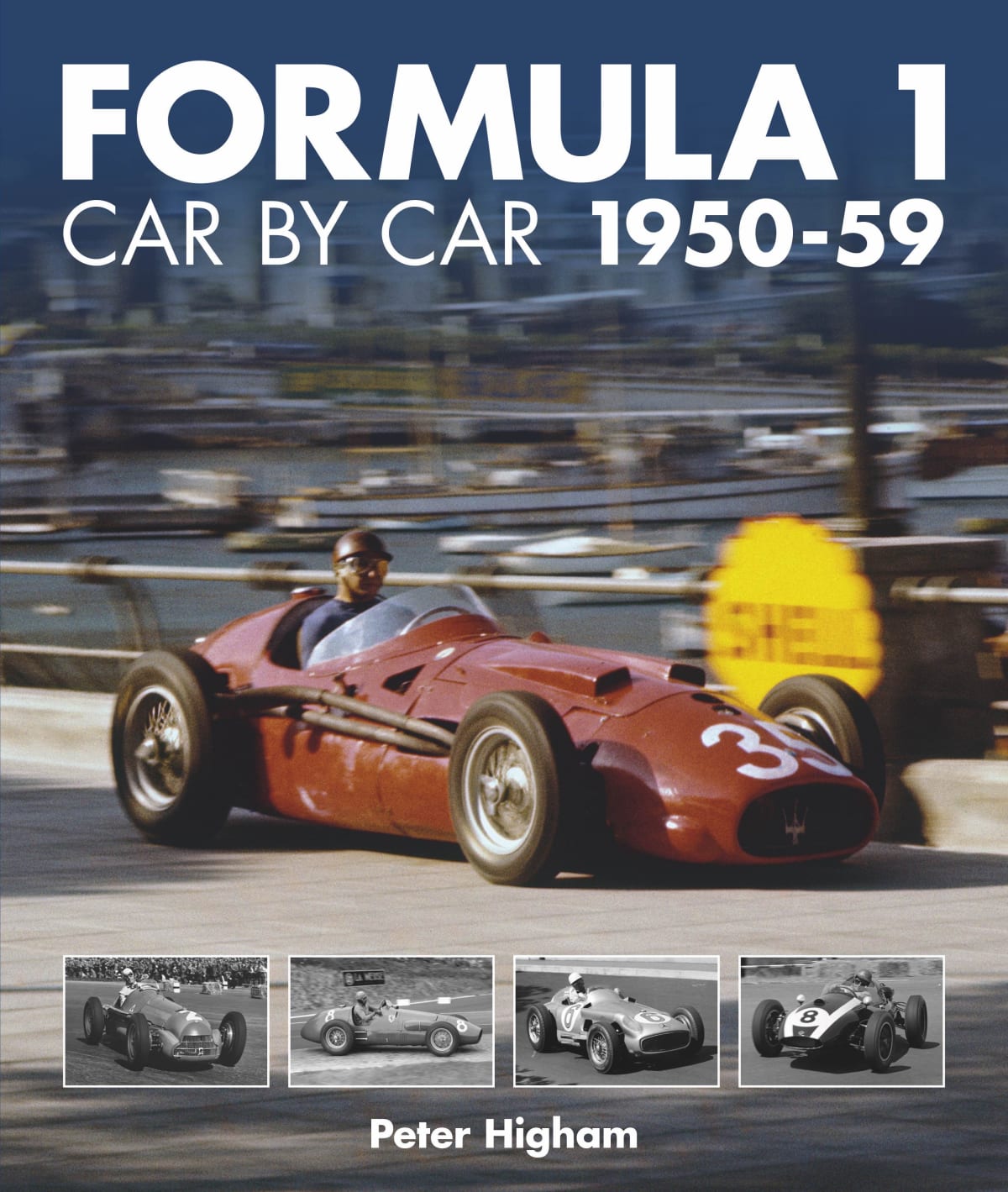
Yes, you read those specs right … there are some 600 (clear, well-chosen and evocative) photos of classic Formula 1 cars featured in the pages of this terrific new look at what many (this writer included) feel was the true “golden age” of Formula 1 … when the tech of the day was easily and often overshadowed by outright driving talent.
The title here touts the cars, but the photographic proof is that this book is spiritually about the drivers and their abilities to control and get maximum performance out of them. The drivers may have been a bit more stout back then, and the tires way thinner than today’s broad ones, but the challenge was there, and it’s well-captured here.
That’s not to say the these wonderful old racing cars were not some of the very best examples of their times and technology, but any comparison with today’s insanely technical* is only possible in terms of a driver’s ability to use what is given them to the highest degree, for the longest amount of time (meaning the full duration of the event being contested).
In 1950, most of the World was just beginning to shake off at least some of the harrowing experiences of World War 2. Peter Higham’s narration begins as European motorsports came out of the mothballs where was reluctantly stored in early 40’s. The sanctioning body (the newly formed FIA) had announced new rules for an international open wheel class of racing cars that would compete using 4.5 liter engines. Interestingly enough they added a provision for forced induction engines to be used but (remembering well the staggering horsepower numbers achieved by certain Teutonic supercharged engines before the war) restricted those engines to 1.5 liters.
The first few years of Formula 1 relied heavily on the cars that had raced prior to the war … they looked it, as did the drivers who wore canvas head coverings (that looked like WW1 pilot's gear) and goggles. Short sleeve sports shirts gave way to light cotton coveralls as time passed.
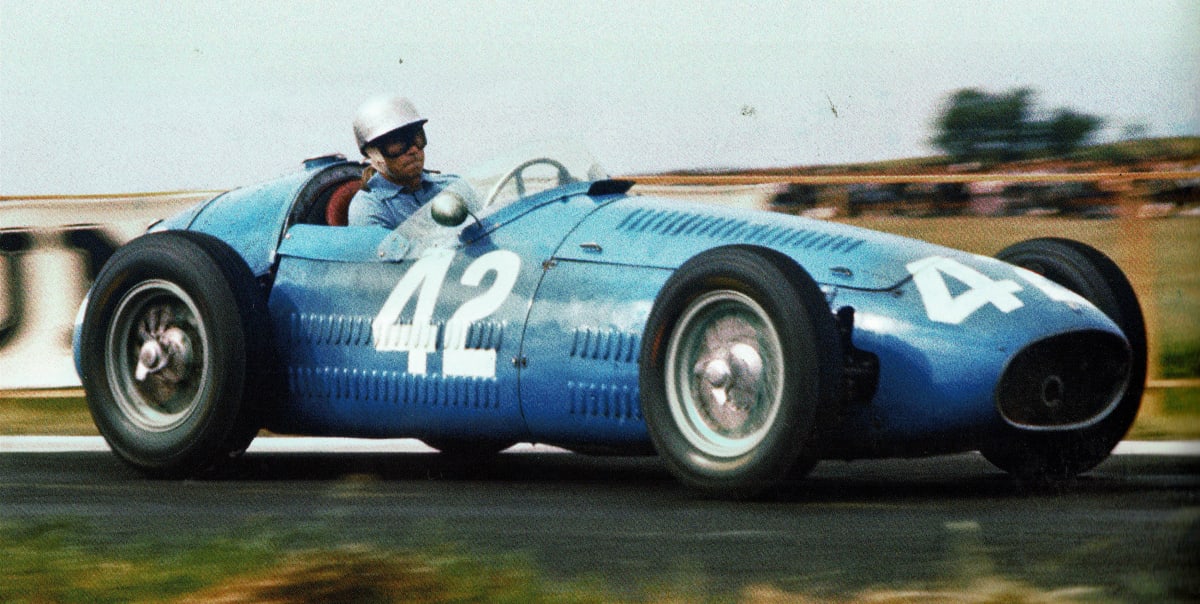
And the shapes of these cars change as the pages turn in Higham’s book, but right though to 1959, the one thing that evident here is the driver is part of the equation, visible, direct, and quite prominently doing the work of racing. In fact what I really was really struck with is that, in every action shot in this book (and my rough guess is that’s about 400 of the 600 total) you can not only see what the driver is doing, but there’s almost a sense of being able to know what he’s thinking.
And the teams and drivers, early in the era, individuals were allowed to enter Formula 1 races and did, setting up small, privately-run and independently financed, many with family money, which may account for a number of titled characters to show up on the driver’s roster for a race, Counts, Barons, and commoners all raced in those days, and as did the “family money” drivers whose bankrolls, on a number of occasions, seemed to have exceeded their driving talent by fair anm.
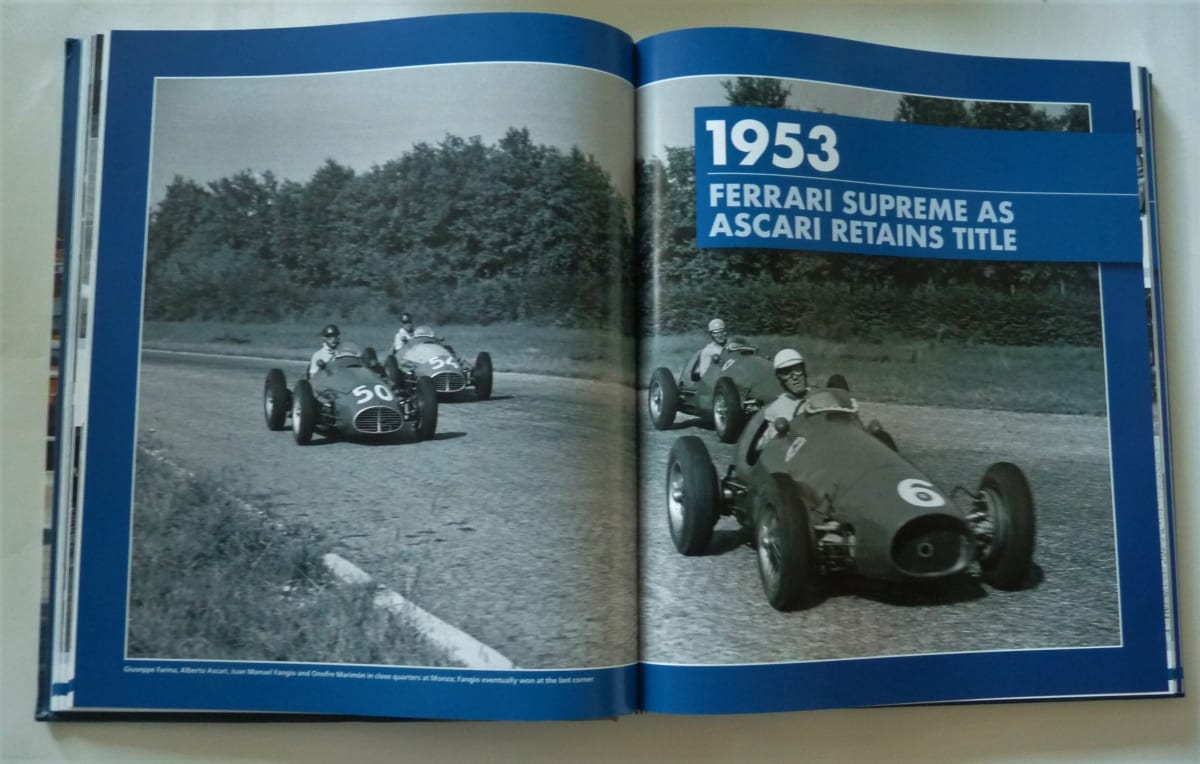
And the cars … pristine shapes, front-motored (until the very last two years of the ten that this book covers) tall, high off the ground, driver sitting upright-erect (most of the time straddling the engine’s spinning driveshaft) and far to the rear where they could sight over the hood and aim the car down the road.
The only bow to “aerodynamics” here was a (relatively) smoothly-shaped body, and in the early years there was no protective roll bar sticking up behind the driver. Most had wire wheels, and all long exhaust pipes running to the rear of the car. As we’ve noted the drivers (although starting to sink down into the cars by ‘58) were all quite visible.
In fact the way that a driver sat in the car made him easy to recognize them in small black and white and that was a good thing because there were no driver names on these cars for the whole decade, and that goes for sponsors as well. Even in small, black and white photos, Fangio’s laid back style contrasted boldly with Harry Schell’s maniacal sawing at the steering as though it had become disconnected, and Stirling Moss, the perfectionist, carving the shortest/fastest way through the corner and already looking down the road to the next challenge that the race course held … each as unique and identifiable as the cars they were driving.
If you’ll allow a movie reference (this is, after all LA Car, right?) The line from classic Sunset Boulevard, “… We didn’t need dialogue, we had faces.” could not be more appropriate here.
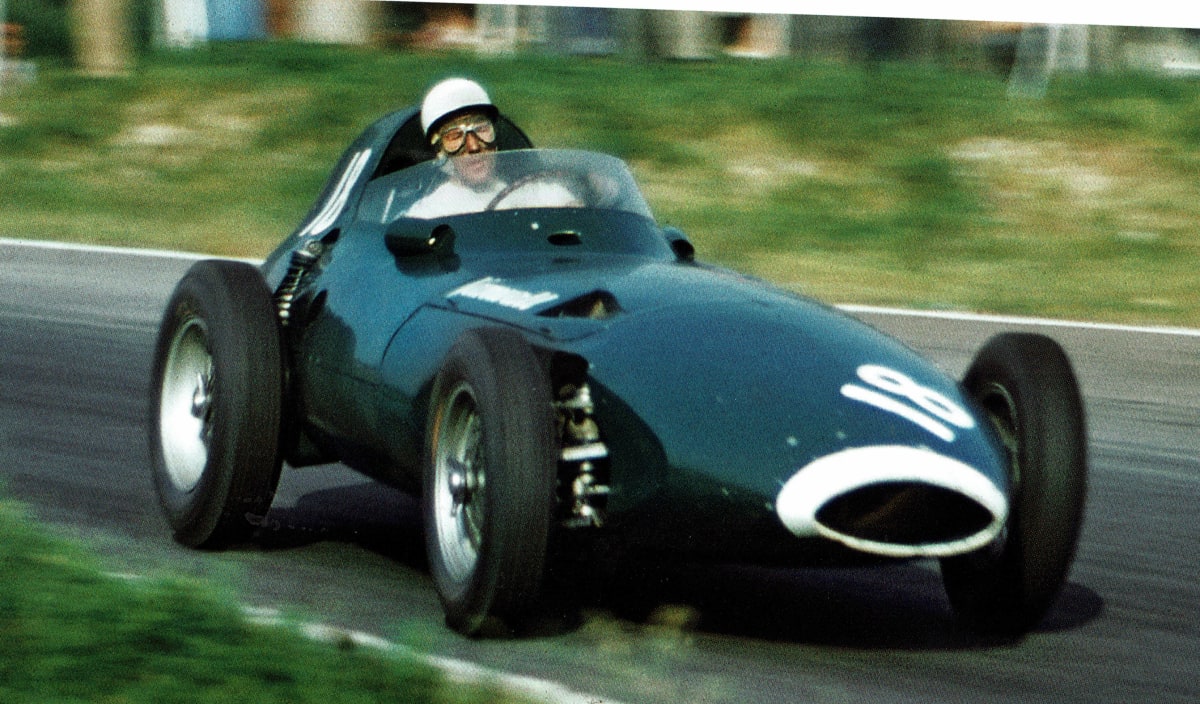
There were some sponsors (and they were all pretty much automotive related, not like today’s panoply of companies that are huge conglomerates) whose logos were not on the cars, but on the transport trucks and up over the pit stalls. There are only about a half dozen photos in this book’s 600 where any sort of a sponsor decal is seen on a car at all … at this magic point in time, the cars are pure and only the badge of each car’s manufacturer is there on the nose so we’ll know a Cooper from a Maserati, and Ferrari from a Vanwall, or a BRM from a Connaught.
On the technical side (of a book that has that target in mind) Higham does quite well for his readers. His narration of the evolution or this time period (which at the very first stages actually saw pre-war race cars filling post-war grids) is clean and well-stated and will likely surprise many recent Formula 1 aficionados. The well-known British journalist here offering a wealth of information regarding the many ot the little-known and mostly forgotten racing teams and marques that came to the starting line during this robust 1950-59 epoch at the dawn of the “modern” era in Grand Prix racing.
The narration follows all three of the prime aspects of the sport: the cars, the drivers, and the races themselves and keeps a steady eye on all three as each seems to have it’s day. The times when the those three forces align and dynasties are founded are well-noted as well.
Each of the ten years that are covered here has a very useful two-page coda following it which charts that year’s race results, lists the F1 Winners, and shows the final positions in that year’s Driver’s championship. Read as a treasure map of sorts, each of these double page offerings present the ebb and flow of the above forces in graphic form,
An interesting sidelight to these ten years is that the Indianapolis 500 was considered and counted as one of the races where drivers would be awarded points in the F1 championship, and a close look at the Driver’s championship will note the names of a number of American** circle track stars, most of whom never even set foot in Europe on vacation, let alone raced there.
And … dominating the era, the Argentine, Juan Manuel Fangio is seen throughout this book winning fully half of the 10 World Championships up for grabs in the period driving for four different car brands and putting up a championship each for Alfa, Ferrari, and Mercedes … with two racked up for Maserati.
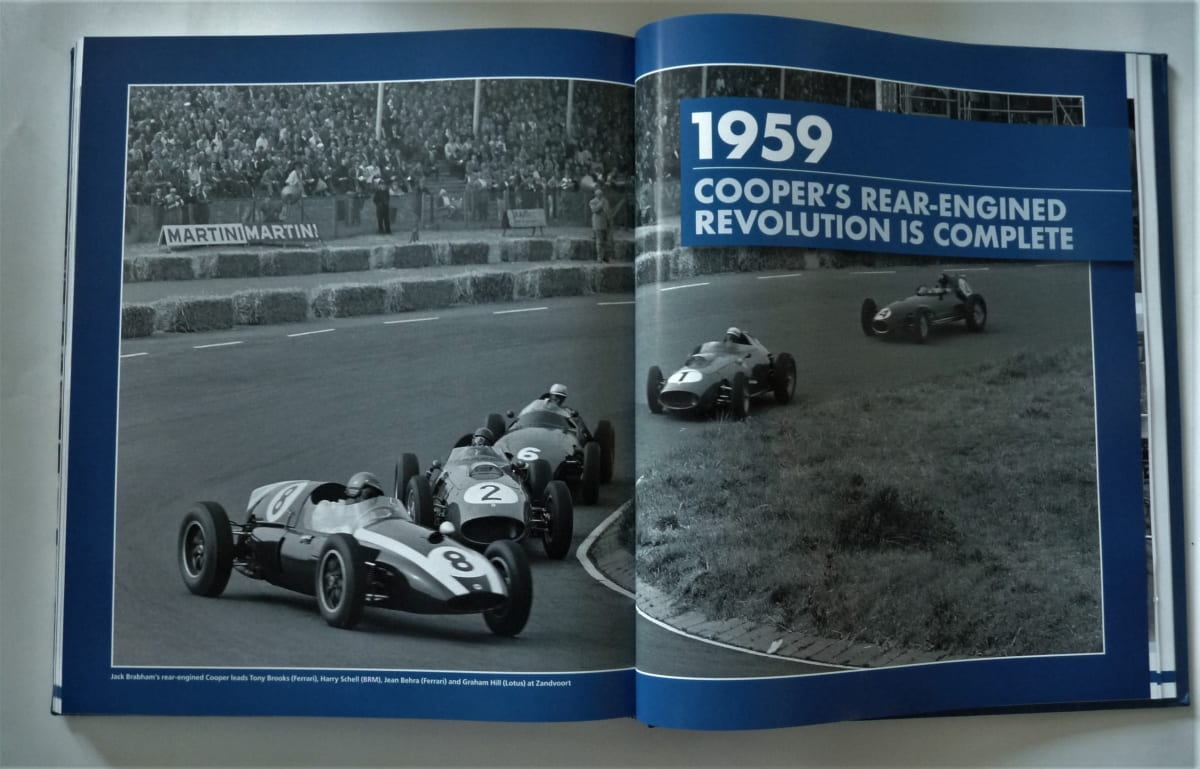
It’s Fangio, who appears quite appropriately on the cover of this book, his calm driving style there on display in yet another winning performance on the tight Monaco street circuit in May of 1957. Though he only raced in total of 51 Formula 1 races (he retired in 1958) in terms of winning percentages Fangio surely qualifies among the greatest of all time. He won 24 races, qualified on the front row 48 times, and set the fastest lap 23 times in his 51 “at bats” in Formula 1.
To make on more Hollywood allusion, just about halfway through the book (1955 in fact) many of the photos suddenly (a bit like Dorothy in the Land of Oz) start appearing in blazing color. The Ferraris and Masers are RED, the BRMs, Coopers, and Vanwalls are dark green, the French cars are powder blue, and the “privateers” (like Oliver Gendebien, from Belgium) are seen in cars with their national racing colors (dark yellow, in Gendebien’s case).
If I have one complaint here its a (relatively) minor one … I miss a glossy dust jacket on this offering … the book is self-covered and (to my old eye) does not look as rich or as important as it very truly is. Of course that in no way affects the excellent content, but for $80 I’d really like to see a separate glossy cover for this one.
And, I probably should have mentioned it earlier, but you have my full and understanding OK to just page through a book like this before you settle in to read the very intelligent commentary that here accompanies so many great photos***.
There’s no way that a true motorsports aficionado can NOT fan this one first. And you might hurt yourself if you think to prove me wrong. -DS
*In recent years, watching F1 racing on TV, has given me the nagging impression that the tech side of the driving equation has taken something away from the driver’s who animate the cars.
**From Johnnie Parsons, Bill Holland, Mauri Rose, Tony Bettenhausen, and Joie Chitwood in 1950 to Johnny Thompson and Paul Goldsmith in ‘59,
***About the photos here, I can’t recall another book on the era that I’ve read that has the number of photographs that were so new to my (old eyes). I love this era, have something of a passion for it, and was really knocked out to see so many great photos from the day.
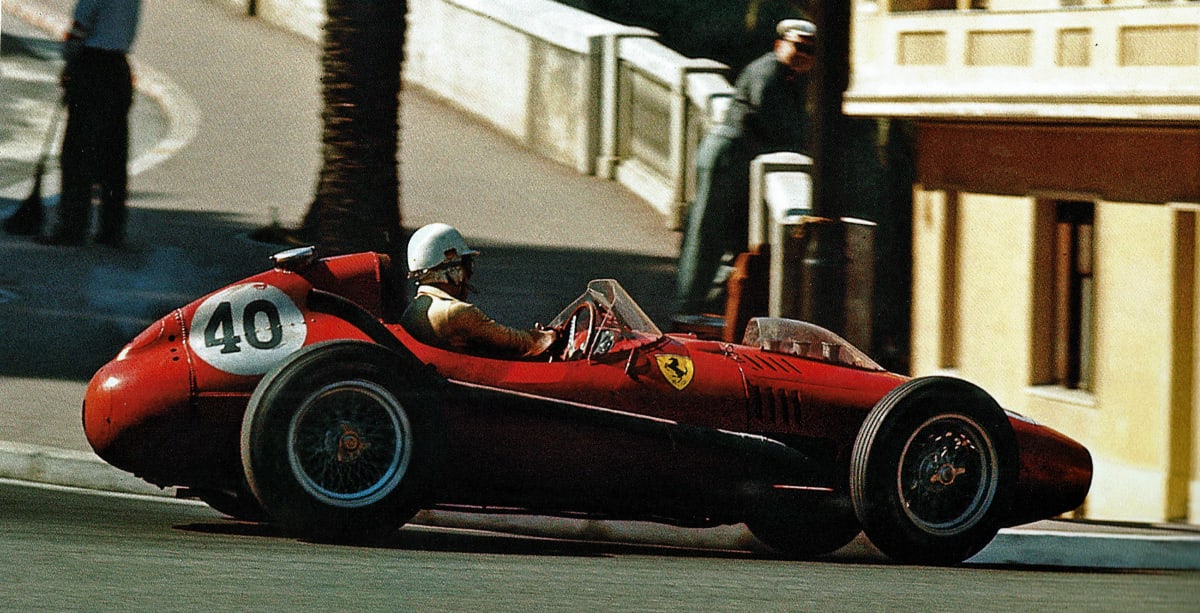
SIDEBAR: THE NAMING OF NAMES
Remember that Formula1 was an open game at the time in question and not a closed, members only, tontine. If you had a car that fit the rules and a driver who was game … you were racing F1.
Of course that all changed pretty rapidly (the seeds of that change are noticeable even here in the 50’s) after 1960 and today the numbers for owning and operating a Formula One team are well beyond outrageous (there will be no numbers quoted here, if you don’t know: it’s a really a lot, if you do know, good on you).
This book will introduce fans to hundreds of racing drivers and at least 50 racing teams from the mighty Mercedes and Ferrari marques to the obscure Veritas, HMW-Alta, and Lago-Talbot “Ecuries”, when cars raced more for glory than either money or advertising, and in the colors of their countries.
Since I mentioned a few of the half-hundred (more) cars you’ll read about and dropped a few driver names above, how about a few more: Mano Alborghetti, Cliff Allison, Rodger Ward, Antonio Ascari, Peter Whitehead, Harry Munday, Bruce McLaren, Graham Hill, Alan Stacey, Carroll Shelby, Jean Berha, John Fitch, and Froilan Gonzales, Hans Klenk, Jack Fairman, Eugenio Castelloti, Dan Gurney, Phil Hill, and Stirling Moss. You’ll meet them all, hear about their racing, and see them in action. Have fun, pace yourself. -DS
